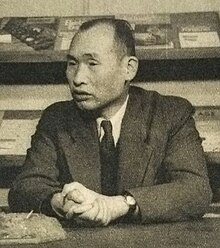Takayanagi Kenjirō
Dr. Takayanagi Kenjirō ( Japanese 高 柳 健 次郎 ; born January 20, 1899 in Hamamatsu , Shizuoka Prefecture ; † July 23, 1990 in Yokosuka ) was one of the first developers of televisions in Japan and is therefore considered the father of Japanese television .
biography
Born in Hamamatsu in 1899 , Takayanagi Kenjirō was a graduate of Tokyo Tech with a doctorate and began research into image transmission possibilities in 1925. At first he developed a system similar to John Logie Baird's , which scanned an object with a Nipkow disk and converted its image into electrical signals. In 1926 he presented the first Japanese black-and-white television at the Hamamatsu Higher Technical School, a forerunner to Shizuoka University . He succeeded in the first electronic transmission of images with a cathode ray tube on the transmitter and receiver side. He first transmitted the katakana イ with the help of a Braun tube . That was a few months before Philo Farnsworth demonstrated his first fully electronic television on September 7, 1927 in San Francisco that did not need a Nipkow disk.
Later, Takayanagi succeeded in the first electronic transmission of a human face. He worked on the development of Nippon Hōso Kyōkai and later JVC , which he led at times as Vice President. He was also involved in the development of color television and video cassettes.
In 1980 Takayanagi Kenjirō was named Bunka Kōrōsha, a person with special cultural merits , and was awarded the Cultural Order in 1981. In 1989 he was awarded the Order of the Holy Treasure .
He died of pneumonia in 1990 .
Individual evidence
- ^ "Kenjiro Takayanagi, Electrical Engineer, 91" , New York Times, July 25, 1990.
literature
- S. Noma (Ed.): Takayanagi Kenjirō . In: Japan. An Illustrated Encyclopedia. Kodansha, 1993, ISBN 4-06-205938-X , p. 1513.
Web links
| personal data | |
|---|---|
| SURNAME | Takayanagi, Kenjirō |
| ALTERNATIVE NAMES | 高 柳 健 次郎 (Japanese) |
| BRIEF DESCRIPTION | Japanese inventor; Father of Japanese television |
| DATE OF BIRTH | January 20, 1899 |
| PLACE OF BIRTH | Hamamatsu , Shizuoka Prefecture |
| DATE OF DEATH | July 23, 1990 |
| Place of death | Yokosuka |

